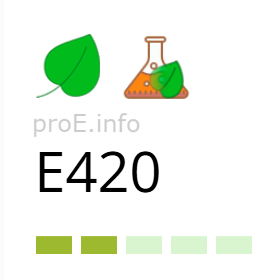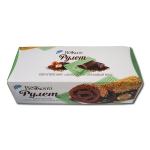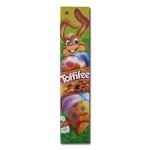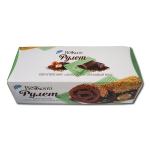
Other names for the additive (synonyms)
General Information
Food additive E420, known in the chemical industry as sorbitol or glucitol, is a sugar alcohol with a mildly sweet taste. The substance belongs to the class of sweeteners.
It is mainly obtained from glucose through hydrogenation. The chemical formula of the substance is C6H14O6.
Additive E420 can be used in two forms:
- E420(i) — sorbitol, or crystalline sorbitol
- E420(ii) — sorbitol syrup, an aqueous solution of sorbitol.
Both forms have similar properties as sweeteners and humectants, but differ technologically. Crystalline sorbitol allows for precise dosing, while the syrup retains moisture better and is more commonly used in soft and moist products, such as fillings, rolls, and dough.
In nature, sorbitol is found in certain algae, stone fruits (apples, apricots), and other plants. Rowan berries are especially rich in sorbitol.
Sorbitol is also naturally formed in the human body but is poorly absorbed. Excessive accumulation in cells may lead to dysfunction.
Effects on the Body
Benefits of Additive E420
In moderate doses, sorbitol is used in dietary nutrition, as it is not a carbohydrate in the traditional sense and does not cause a sharp rise in blood glucose levels. Therefore, it is suitable for diabetics. Sorbitol also helps preserve vitamins B1 and B6 in the body and improves gut microbiota.
Studies in rats show that sorbitol has a mild prebiotic effect, promoting the growth of beneficial gut bacteria.
Risks of Additive E420
In high doses, additive E420 has a laxative effect, the severity of which is directly proportional to the amount consumed. Therefore, sorbitol is also used in laxative medications.
Excessive consumption of sorbitol may lead to bloating, diarrhea, and abdominal pain. Sensitive individuals may experience these symptoms even at doses below 20 g per day. Long-term overconsumption may be harmful, especially for people with metabolic disorders.
Excess sorbitol in diabetics, especially when blood glucose is poorly controlled, may contribute to the development of diabetic neuropathy and tissue damage due to its accumulation in cells.
In June 2023, EFSA initiated the collection of additional data on the genotoxicity of sorbitol, including the performance of an in vitro micronucleus test.
Uses
In the food industry, E420 is used as a sweetener, emulsifier, complexing agent, and texturizer. Due to its ability to absorb moisture from the air, sorbitol helps keep products fresh longer — thus also acting as a humectant.
Sorbitol syrup is used in sugar-free confectionery products intended for diabetics. Sorbitol is also found in rolls, cakes, and other baked goods.
Beyond food, sorbitol is used in the production of medicines (including cough syrups, laxatives), cosmetics, and toothpaste, where it functions as a humectant and stabilizer.
Legal Status
Food additive E420 is approved for use in the European Union, the United States, and other countries.
Its use is regulated depending on the category of products in which it is applied. In the EU, the additive is listed in the Codex Alimentarius as safe for use as a sweetener and humectant.



